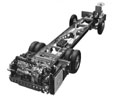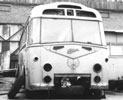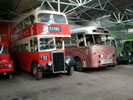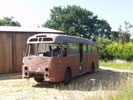Foden PVRF6 / Harrington Wayfarer
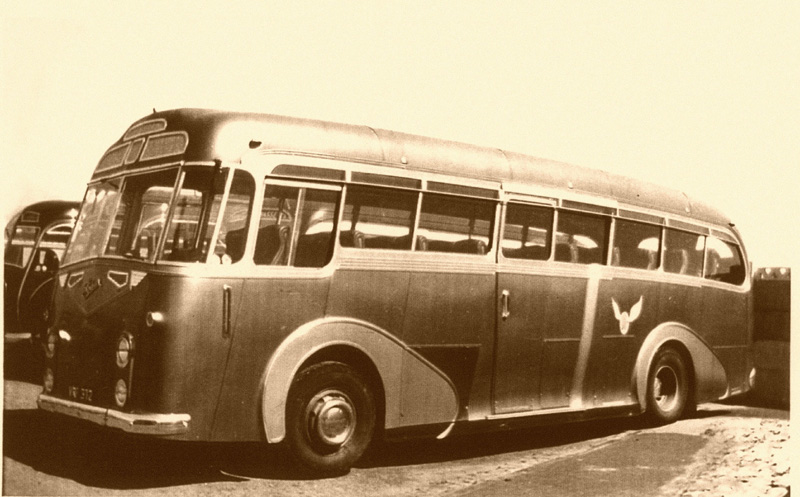
Click on Thumbnail for larger image.
VRF 372 was delivered new to Bassetts Coachways of Tittensor,
Stoke on Trent and remained with them until 1999 when it joined my collection
of Harrington bodied vehicles. It is chassis number: 30664 and carries Harrington
Wayfarer C41C body number 921. The photograph above shows it when nearly new. At this time it was
painted in striking metallic grey and blue. The Bassetts logo on the side
appears to be painted on, unlike later vehicles which carried a polished aluminium
device.
Some buses and coaches become rare when others of their type are scrapped. Some are made in very small numbers and start out life as rare. This coach is one of the latter. It is the second of only three-rear engine Foden chassis bodied by Thomas Harrington of Hove, although a number of bodies had been built earlier for front engine Foden chassis. It was the only one powered by the Foden FD6, the other two being fitted with Gardner 6LW engines. The original chassis specification sheet states that this chassis was to be constructed to show finish. It was unique in having a 17 foot wheelbase, 6 inches longer than standard. Quite why the difference is unknown. It was drawn up in May 1950 for supply to Lancashire Motor Traders who presumably would have taken delivery after the motor show of that year. However it must be assumed that given the chance to supply directly to a final customer, Fodens gave priority to the order from Bassetts and the chassis became theirs on the 4th January 1951. After the body had been fitted it was registered on 1st June 1951. As previously mentioned, VRF 372 was the second of three Harringon bodies on Foden PVR chassis. Due to the time between construction and delivery of chassis number 30664, the first finished example from Harrington (body 910) which went through the previous month was actually on a younger chassis.
It was last used in 1966. In the late 1970s a considerable amount of restoration work was done on the wooden frame but owing to pressure of work this was not completed and the coach was stored away until August 1999 when the decision was made to sell.
Foden PVR The Foden rear engine chassis was introduced in 1950 and was a variation of an existing front engine design. The rear engine layout meant that the chassis was suitable for the types of bodywork now being fitted to under-floor chassis designs from large manufacturers such as AEC and Leyland. Despite the fact that this particular configuration is now widely accepted in the bus and coach business, the Foden failed to find the sales its advanced specification deserved. Only 54 chassis were delivered to the UK market. In true Foden tradition it was heavily over engineered and this was reflected in the price. Also in a traditionally conservative market still coming to terms with the passing of the half-cab style, many features of the chassis may have represented too much of a change at that time. The provision of sidelockers was looked upon as a poor substitute for a large boot, which of course now had an engine in it. The brakes are a complicated Lockheed "hydraulic over hydraulic" system. This features an oil pump driven by the engine which provides a constant circulation of high-pressure fluid. When the brakes are applied the oil is admitted to a chamber in the cylinder for the conventional hydraulic circuit and provides power assistance to the foot pedal. Although the hydraulic system is by Lockheed, Foden designed the mechanical aspects of the brakes themselves.
The design of engine used in this chassis dates back to 1947 and the four cylinder FD4. The six-cylinder FD6 version followed shortly afterwards and was fitted to Foden's conventional front engine chassis in both single and double deck versions. It was also fitted to Foden trucks and this continued until the early 1970's, long after Foden had withdrawn from the PSV market. It is an in line six cylinder two stroke diesel and originally developed 126 b.h.p. from a capacity of 4.1 litres. VRF 372 is now fitted with a mark 1 engine rebuilt to mark 2 standard after the original engine caught fire while receiving attention at the Foden works. The mark 1 had two cylinder heads but the mark 2 had a separate cylinder head for each cylinder and was less prone to overheating and stress cracking between the valve seats. This later version of the engine which develops 150 b.h.p. against the original 126 b.h.p. As is usual with two stroke diesels it is supercharged and air is fed into the combustion chamber through ports in the cylinder walls. The exhaust arrangement is more usually associated with four stroke engines and is by conventional poppet valves, although there are two per cylinder. These engines were noted for their particularly sporting exhaust note when under load.
